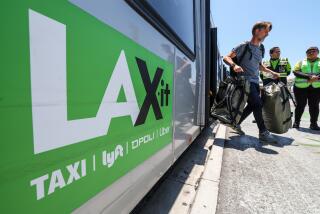Transportation Zones Are Good for All
- Share via
Over the past three years, we have seen dramatic improvements at the Metropolitan Transportation Authority under the strong leadership of Chief Executive Julian Burke. The bus system is finally the MTA’s top priority, as evidenced by new bus purchases and service expansion. Despite tough decision-making and many positive results, however, bus service improvements can and must move faster and with more local input. We must spend precious tax dollars more efficiently and give people better access.
Transportation zones can help meet these goals by providing more efficient, effective bus service throughout Los Angeles. A transportation zone is an independent body charged with managing the bus operations in a particular area in the county. The zone concept has proved successful with Foothill Transit in the San Gabriel Valley. Today, I will make a proposal for a study on a new zone for the San Fernando Valley.
Ultimately, the MTA has the responsibility to approve and fund new zones. Zones offer more local control, lower costs and the opportunity to provide more bus service throughout Los Angeles.
The benefits of transportation zones are not limited to the San Fernando and San Gabriel valleys. Zones are good public policy for all areas, regardless of where you live or what district you represent. First, a smaller bus operation will allow MTA management to spend more time focusing on improving the quality of service--especially in high-ridership areas--and reducing costs at each remaining MTA bus division. The MTA share of zone savings can be used to expand service, lower fares or make other service improvements. MTA bus service also will improve as a result of transportation zones.
Concerns have been raised about the potential impact of zones on MTA workers and riders. Any zone will have to abide by current labor contracts as well as federal and state labor law.
Unless otherwise requested by MTA unions, it is expected that labor contracts will be transferred to zones. Critics have made unfounded accusations that zones will erode worker salaries and benefits. In fact, zones will achieve their cost savings through better management and less overhead compared to MTA’s large central bureaucracy.
Savings will not come from cutting worker salaries or benefits.
Skeptics also have attacked zones as inefficient, comparing them to a time when multiple bus companies provided uncoordinated, duplicative and competing service. To the contrary, federal data clearly show that smaller bus operations are less expensive to operate. In an era of increased competition for federal, state and local funds, we must pursue cost-effective alternatives.
Concerned parties have questioned whether zones will hurt inner-city residents. The MTA zone guidelines address this issue head on. Zones cannot negatively impact other MTA service areas. The MTA also can mandate service levels in zones, ensuring that those who rely on public transportation have adequate service.
Finally, the MTA and each zone will honor each other’s bus passes, ensuring that transit customers have seamless and equal access to bus service throughout Los Angeles.
I will not support any zone proposal that hurts taxpayers or people who rely on public transportation for their livelihood. The original zone benefits presented to the MTA board last April--more local control, lower cost and more service--can and will improve countywide bus service.
The next steps in the process involve identifying how the MTA can cut the most fat from its operation, while each zone develops its financial and operating plans.
Zones are not a panacea for all our transportation challenges, but better bus service means viable alternatives to driving and attendant traffic snarls, while improving access to jobs and other opportunities throughout Los Angeles for those who rely on public transportation. And that is good for the whole region.
More to Read
Sign up for Essential California
The most important California stories and recommendations in your inbox every morning.
You may occasionally receive promotional content from the Los Angeles Times.













